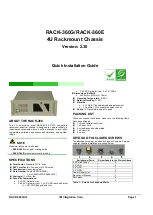
1-14
Cisco ASA Series CLI Configuration Guide
Chapter 1 Configuring IPsec and ISAKMP
Configuring ISAKMP
For example, the following command sets the peer identification method to hostname:
hostname(config)#
crypto isakmp identity hostname
Enabling IPsec over NAT-T
NAT-T lets IPsec peers establish a connection through a NAT device. It does this by encapsulating IPsec
traffic in UDP datagrams, using port 4500, which provides NAT devices with port information. NAT-T
auto-detects any NAT devices and only encapsulates IPsec traffic when necessary. This feature is
disabled by default.
Note
Due to a limitation of the AnyConnect client, you must enable NAT-T for the AnyConnect client to
successfully connect using IKEv2. This requirement applies even if the client is not behind a NAT-T
device.
With the exception of the home zone on the Cisco ASA 5505, the ASA can simultaneously support
standard IPsec, IPsec over TCP, NAT-T, and IPsec over UDP, depending on the client with which it is
exchanging data.
The following breakdown shows the connections with each option enabled.
Note
When IPsec over TCP is enabled, it takes precedence over all other connection methods.
When you enable NAT-T, the ASA automatically opens port 4500 on all IPsec-enabled interfaces.
The ASA supports multiple IPsec peers behind a single NAT/PAT device operating in one of the
following networks, but not both:
•
LAN-to-LAN
•
Remote access
In a mixed environment, the remote access tunnels fail the negotiation because all peers appear to be
coming from the same public IP address, address of the NAT device. Also, remote access tunnels fail in
a mixed environment because they often use the same name as the LAN-to-LAN tunnel group (that is,
the IP address of the NAT device). This match can cause negotiation failures among multiple peers in a
mixed LAN-to-LAN and remote access network of peers behind the NAT device.
Options
Enabled Feature
Client Position
Feature Used
Option 1
If NAT-T is enabled
and client is behind NAT, then NAT-T is used
and no NAT exists, then
Native IPsec (ESP) is used
Option 2
If IPsec over UDP is enabled
and client is behind NAT, then IPsec over UDP is used
and no NAT exists, then
IPsec over UDP is used
Option 3
If both NAT-T and
IPsec over UDP are enabled
and client is behind NAT, then NAT-T is used
and no NAT exists, then
IPsec over UDP is used
Summary of Contents for 5505 - ASA Firewall Edition Bundle
Page 28: ...Glossary GL 24 Cisco ASA Series CLI Configuration Guide ...
Page 61: ...P A R T 1 Getting Started with the ASA ...
Page 62: ......
Page 219: ...P A R T 2 Configuring High Availability and Scalability ...
Page 220: ......
Page 403: ...P A R T 2 Configuring Interfaces ...
Page 404: ......
Page 499: ...P A R T 2 Configuring Basic Settings ...
Page 500: ......
Page 533: ...P A R T 2 Configuring Objects and Access Lists ...
Page 534: ......
Page 601: ...P A R T 2 Configuring IP Routing ...
Page 602: ......
Page 745: ...P A R T 2 Configuring Network Address Translation ...
Page 746: ......
Page 845: ...P A R T 2 Configuring AAA Servers and the Local Database ...
Page 846: ......
Page 981: ...P A R T 2 Configuring Access Control ...
Page 982: ......
Page 1061: ...P A R T 2 Configuring Service Policies Using the Modular Policy Framework ...
Page 1062: ......
Page 1093: ...P A R T 2 Configuring Application Inspection ...
Page 1094: ......
Page 1191: ...P A R T 2 Configuring Unified Communications ...
Page 1192: ......
Page 1333: ...P A R T 2 Configuring Connection Settings and QoS ...
Page 1334: ......
Page 1379: ...P A R T 2 Configuring Advanced Network Protection ...
Page 1380: ......
Page 1475: ...P A R T 2 Configuring Modules ...
Page 1476: ......
Page 1549: ...P A R T 2 Configuring VPN ...
Page 1550: ......
Page 1965: ...P A R T 2 Configuring Logging SNMP and Smart Call Home ...
Page 1966: ......
Page 2059: ...P A R T 2 System Administration ...
Page 2060: ......
Page 2098: ...1 8 Cisco ASA Series CLI Configuration Guide Chapter 1 Troubleshooting Viewing the Coredump ...
Page 2099: ...P A R T 2 Reference ...
Page 2100: ......










































